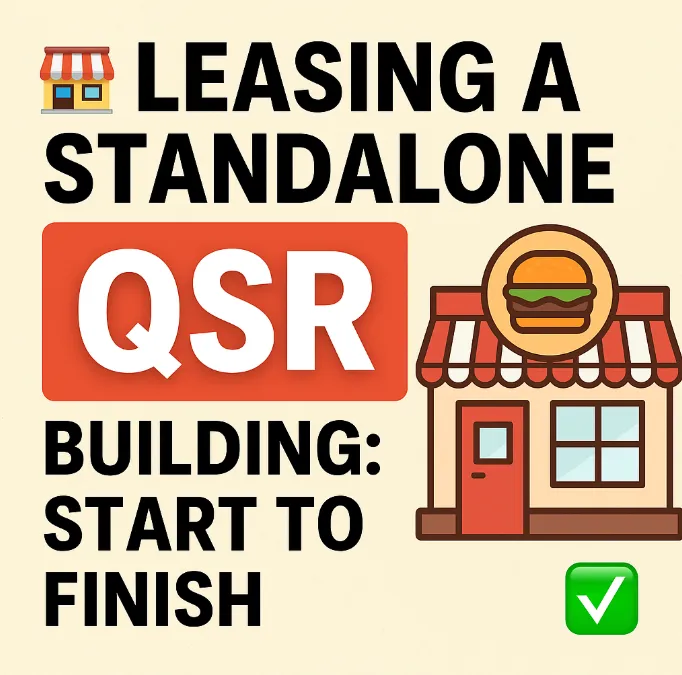
🍔 QSR Leasing 101: How to Lease a Standalone Restaurant Space from Start to Finish 🚀
🍔 QSR Leasing 101: How to Lease a Standalone Restaurant Space from Start to Finish 🚀
🏪 Quick-Service Restaurant Leasing Guide: Site Selection to Signing Done Right ✅
🏪 Leasing a Standalone QSR Building: Start to Finish
If you're a restaurateur, franchisee, or investor looking to lease a standalone quick-service restaurant (QSR) building, you’re stepping into one of the most competitive—and rewarding—real estate niches in the country. From Chick-fil-A to Raising Cane’s, QSRs thrive in prime locations and demand high foot and drive-thru traffic.
Here’s a complete guide to leasing a QSR property the right way—from site selection to lease negotiation and beyond.
📍 Step 1: Define Your Needs
Before touring properties, define your specific requirements:
· Size: Most QSR buildings range from 1,800–3,500 SF.
· Drive-Thru: Essential for most national brands post-COVID.
· Visibility: Hard corners and high-traffic intersections are ideal.
· Access & Parking: Must accommodate quick entry/exit and ample parking.
🧭 Step 2: Site Selection & Market Analysis
Location is everything in QSR. Work with a commercial real estate broker to:
· Analyze traffic counts, demographics, and competition
· Identify zoning and use restrictions
· Determine if you want to lease existing space or go build-to-suit
💡 Pro Tip: Consider new developments in high-growth areas like Katy or Fulshear where major retail anchors are drawing new customers.
📄 Step 3: Lease Types to Know
When it comes to standalone QSR buildings, most leases fall into one of these:
· NNN (Triple Net): Tenant covers taxes, insurance, and maintenance.
· Ground Lease: You lease the land and construct your own building.
· Build-to-Suit Lease: Developer builds your restaurant to spec and leases it back.
Each structure affects your rent, control, and long-term flexibility.
🤝 Step 4: Lease Negotiation Tips
Don’t sign until you:
· Negotiate tenant improvement (TI) allowances
· Ensure exclusivity rights in retail centers
· Add exit clauses if performance benchmarks aren’t met
· Review renewal options and rent escalations carefully
💼 A real estate attorney or experienced broker can help protect your interests.
🛠️ Step 5: Permitting & Buildout
Even if the building is second-generation, you’ll likely need:
· Health department and food service permits
· City occupancy and business licenses
· Buildout plans that meet ADA, code, and fire regulations
Be sure to factor buildout timelines into your go-to-market plan.
✅ Step 6: Grand Opening Support
Once your lease is signed and space is built out:
· Launch a marketing blitz
· Leverage local press and digital platforms
· Host a soft opening before the grand launch
Final Thoughts
Leasing a standalone QSR building isn’t just about signing paperwork—it’s about aligning the right real estate strategy with your operational goals. Whether you’re expanding a franchise or launching a new concept, your location is your brand.
Need help finding or leasing a QSR space in Texas? Let’s talk.
https://www.houstonrealestatebrokerage.com/
https://www.houstonrealestatebrokerage.com/houston-cre-navigator
https://www.commercialexchange.com/agent/653bf5593e3a3e1dcec275a6
http://expressoffers.com/[email protected]
https://app.bullpenre.com/profile/1742476177701x437444415125976000
https://author.billrapponline.com/
https://www.amazon.com/dp/B0F32Z5BH2
© 2023-2024 Bill Rapp, Broker Associate, eXp Commercial Viking Enterprise Team
